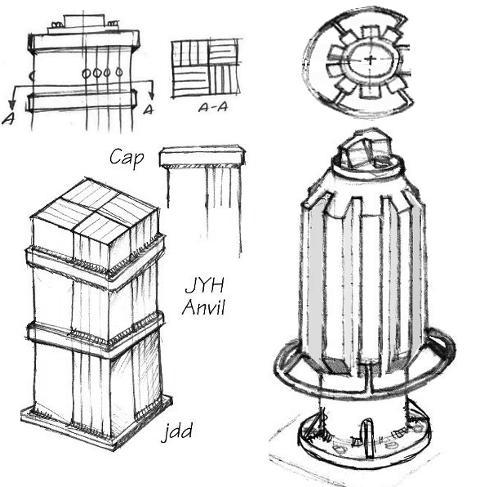| anvilfire! Power hammer Page 12 Page 1 | Page 10 EC-JYH II | Page 11 Bow Springs | |
Built Up Power Hammer Anvils
| |
|
Heavy Steel is often hard to find, expensive to buy and difficult to get cut.
A built up anvil is a suitable solution to supply problems if done correctly.
Shown are two ways to achieve this.
Square Built up Anvil: Using heavy bar from 1/2" (13mm) to 1" (25mm) or more and 3" (75mm) to 4" (100mm) wide a square anvil can be assembled. Using four groups of bar that form squares the whole can be securely welded together and each bar forming a connection to the cap. This method should have a cap 1-1/2" (38mm) to 2" (50mm) thick welded to the top. The cap can be greater than, equal to of smaller than the anvil and welded all around. The pieces for this should be sawn as accurately as possible and stacked with one end as flat and square as possible. The better (flat) end is the where the cap will be welded. Tack weld all the pieces together then weld the collars and end plates. Round Add on Anvil: We often find heavy shaft for a treadle or power hammer in the 6" (150mm) to 8" (200mm) range. While this is a good start it is often too light for the size machine being built. These sizes only give you a 288 to 513 pound (131 to 233 kg) anvil. To increase this we can add material to the outside. The drawing above is of a 6.5" (165mm) round, 36" (915mm) long. It weighs 331 (150kg) with the heavy chamfer. Adding eight 24" (610mm) pieces of 2" (50mm) square stock will increase the weight by 218 (99kg) to a total of 549 pounds (249kg). Add on pieces can be square stock or heavy flat bar. These would give the appearance of cooling fins. Note that by cutting each piece alternately at a 45° angle there is no waste in producing the chamfered ends. Style: There is no reason for a DIY or Junk Yard machine to look ugly and have no style. Chamfering both the anvil (which gives better working clearance) and the add on pieces creates an interesting well thought out look. We are artist craftsmen and should approach these projects that way. Design: While both these ideas were intended for the DIY builder they are perfectly suitable for a commercial machine. If you use them, please remember where these ideas came from. See these designs realized on the anvilfire-X1 Power Hammer Anvils |
|
|
Page 12
|
|